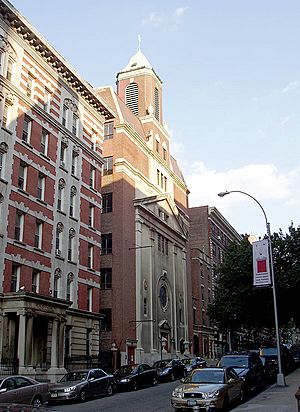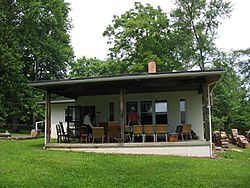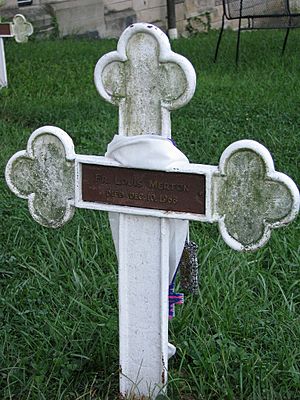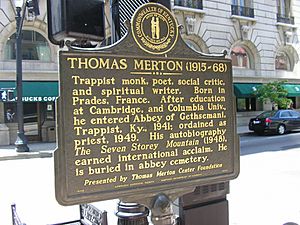Thomas Merton facts for kids
Quick facts for kids Thomas Merton |
|
 |
|
| Born | January 31, 1915 in Prades, Pyrénées-Orientales, France |
|---|---|
| Died | December 10, 1968 (aged 53) in Samut Prakan, Thailand |
| Nationality | American |
| Church | Latin Church |
| Ordained | 1949 |
| Writings | The Seven Storey Mountain (1948) |
Thomas Merton (January 31, 1915 – December 10, 1968) was an American Trappist monk and a well-known writer. He was also a mystic, poet, and someone who worked for social change. He studied different religions too. On May 26, 1949, he became a Catholic priest and was known as "Father Louis". He lived at the Abbey of Our Lady of Gethsemani in Kentucky from 1941 until he passed away.
Merton wrote over 50 books in 27 years. Most of his books were about spirituality, social justice, and peaceful ways to solve problems. He also wrote many essays and reviews. One of his most famous books is his autobiography, The Seven Storey Mountain (1948). This book shared his spiritual journey and inspired many people, including soldiers from World War II, students, and teenagers, to explore monasteries.
Merton became a strong supporter of understanding between different faiths. He learned about Eastern religions by studying their spiritual practices. He is famous for starting conversations with important Asian spiritual leaders. These included the Dalai Lama, Japanese writer D. T. Suzuki, Thai Buddhist monk Buddhadasa, and Vietnamese monk Thich Nhat Hanh. He traveled a lot to meet them and attend religious conferences. He also wrote books about Zen Buddhism, Confucianism, and Taoism, and how they related to Christianity. This was very unusual at the time, especially for religious people in the United States.
Contents
Biography
Early Life of Thomas Merton
Thomas Merton was born in Prades, France, on January 31, 1915. His parents, Owen Merton and Ruth Jenkins Merton, were artists from Wales and America. They met at a painting school in Paris. Thomas was baptized in the Church of England, as his father wished. His father was often away when Thomas was a child.
During the First World War, in August 1915, the Merton family moved from France to the United States. They first lived with Ruth's parents in Queens, New York. Then they settled nearby in Douglaston. In 1917, the family moved to Flushing, Queens, where Thomas's brother, John Paul, was born on November 2, 1918. The family was thinking about going back to France when Ruth was diagnosed with a serious illness. She passed away from it on October 21, 1921. Thomas was six years old, and his brother was not yet three.
In 1926, when Thomas was eleven, his father sent him to a boys' boarding school in Montauban, France. In the summer of 1928, his father took him out of the school, saying the family was moving to England.
College Years
In October 1933, Thomas Merton, at age 18, started studying Modern Languages (French and Italian) at Clare College in England.
In January 1935, Merton, then 20, enrolled as a second-year student at Columbia University in Manhattan. There, he made strong and lasting friendships. These friends included Ad Reinhardt, a painter, poet Robert Lax, writer Ralph de Toledano, lawyer John Slate, and publisher Robert Giroux.
Merton took a course on 18th-century English literature. It was taught by Mark Van Doren, a professor he remained friends with for life.
In January 1938, Merton earned his Bachelor of Arts degree in English from Columbia. In June, a friend arranged for him to meet Mahanambrata Brahmachari, a Hindu religious leader visiting New York. Merton was very impressed by him, feeling that the monk was very close to God. Merton expected the monk to suggest he become Hindu. Instead, the monk told Merton to look into the religious traditions of his own culture. He suggested Merton read The Confessions by Augustine and The Imitation of Christ. Merton read both books.
Merton decided to learn more about Catholicism. In August 1938, he went to Mass at Corpus Christi Church. This church was near the Columbia campus. The Mass was new to him, but he listened carefully. After this, Merton started reading more about the Catholic faith.
On November 16, 1938, Thomas Merton was baptized at Corpus Christi Church and took part in Holy Communion. On February 22, 1939, Merton received his Master of Arts degree in English from Columbia University. Merton decided to continue his studies for a higher degree at Columbia. He moved from Douglaston to Greenwich Village.
Life as a Monk
On December 10, 1941, Thomas Merton arrived at the Abbey of Gethsemani. He stayed at the monastery's guest house for three days, waiting to be accepted into the Order. The monk in charge of new members would interview Merton to see if he was serious and suitable. While waiting, Merton polished floors and washed dishes. On December 13, Frederic Dunne, the abbot (leader) of Gethsemani, accepted him as a postulant (someone asking to join). Merton's first few days were not easy. He had a bad cold from sitting by an open window in the guest house to show how serious he was. In his first weeks at Gethsemani, Merton learned the special Cistercian sign language and the daily schedule of work and worship.
In March 1942, Merton was accepted as a novice (a new monk) at the monastery. In June, he received a letter from his brother John Paul. John Paul said he was going to war soon and would visit Gethsemani before leaving. On July 17, John Paul arrived, and the brothers caught up. John Paul wanted to become Catholic. By July 26, he was baptized at a church nearby and left the next day. This was the last time the brothers saw each other. John Paul died on April 17, 1943, when his plane crashed over the English Channel. A poem by Merton about John Paul is in The Seven Storey Mountain.
Becoming a Writer
Merton kept journals throughout his time at Gethsemani. At first, he felt writing went against his calling as a monk. He worried it would make him too focused on himself. But his superior, Dunne, saw that Merton was very smart and a talented writer. In 1943, Merton was asked to translate religious texts and write biographies of saints for the monastery. Merton worked on his new writing tasks with the same energy he showed in the farmyard.
On March 19, 1944, Merton made his temporary promises as a monk. He was given the special white cowl, black scapular, and leather belt. In November 1944, a book of poetry Merton had given to his friend Robert Lax was published. It was called Thirty Poems. Merton had mixed feelings about this, but Dunne wanted him to keep writing. In 1946, another poetry book by Merton, A Man in the Divided Sea, was published. These books made him somewhat known. The same year, Merton's book The Seven Storey Mountain was accepted for publication. This book, Merton's autobiography, was written in two-hour sessions in the monastery's writing room as a personal project.
By 1947, Merton felt more comfortable as a writer. On March 19, he made his solemn promises, committing to live his life at the monastery. He also started writing to a Carthusian monk in England. Merton had always liked the Carthusian Order and later thought about leaving the Cistercians for them. On July 4, a Catholic magazine published an essay by Merton called Poetry and the Contemplative Life.
In 1948, The Seven Storey Mountain was published and received great reviews. Merton received a lot of fan mail. He also published several works for the monastery that year. These included Guide to Cistercian Life and The Spirit of Simplicity. That year, a college also published a booklet by Merton, What Is Contemplation? Merton's abbot, Dunne, passed away on August 3, 1948. This was very sad for Merton, who saw Dunne as a father figure and spiritual guide. On August 15, the monks chose Dom James Fox as their new abbot. In October, Merton talked to Fox about his interest in other monastic orders. Fox told Merton he belonged at Gethsemani. Fox allowed Merton to continue writing, as Merton was now very well known outside the monastery. On December 21, Merton became a subdeacon. From 1948 on, Merton identified as an anarchist, meaning he believed in a society without a ruling government.
On January 5, 1949, Merton applied for American citizenship. That year, Seeds of Contemplation and The Waters of Siloe were published. On March 19, Merton became a deacon, and on May 26, he became a priest. He said his first Mass the next day. In June, the monastery celebrated its 100th year, and Merton wrote a book for it. In November, Merton started teaching mystical theology to new monks, which he really enjoyed. By this time, Merton was very successful outside the monastery. The Seven Storey Mountain had sold over 150,000 copies. In the years that followed, Merton wrote many more books, gaining a large number of readers. He often revised Seeds of Contemplation, thinking his early version had mistakes and was not mature enough. His writings often focused on a person's place in society, views on social action, and different ways of praying and living a thoughtful life.
During this busy time, Merton may have felt very lonely and stressed. One example of this was when he drove the monastery's jeep very wildly, almost causing a crash.
Over his many years at Gethsemani, Merton changed from a young monk focused inward to a writer and poet who thought deeply about the world. Merton became known for talking with people of other faiths and for his peaceful stand during the race riots and Vietnam War of the 1960s.
By the 1960s, he had a broad view of humanity. He cared deeply about the world and issues like peace, fairness for all races, and social equality. He developed a personal way of thinking that was radical but not based on any specific political idea. It was rooted in non-violence. He saw his viewpoint as simple and expressed it as a Christian belief. His book New Seeds of Contemplation was published in 1961. In a letter to a priest, Merton wrote: "The world is full of great criminals with enormous power, and they are in a death struggle with each other. It is a huge gang battle..."
Merton finally found the quiet he wanted when he lived in a small hermitage on the monastery grounds in 1965. Over the years, he sometimes argued with his abbots because he was not allowed to leave the monastery, even though he was famous worldwide and wrote to many well-known people.
At the end of 1968, the new abbot, Flavian Burns, allowed Merton to travel to Asia. There, he met the Dalai Lama in India three times. He also met a Tibetan Buddhist master. Then, he went on a quiet retreat near Darjeeling, India. In Darjeeling, he became friends with a prominent member of the Tibetan community. In what was his last letter, he wrote that he felt comfort in his own faith in Christ when meeting these new friends.
Merton's role as a writer is explored in novelist Mary Gordon's book On Merton (2019).
Personal Life
According to The Seven Storey Mountain, young Merton loved jazz music. But by the time he started his first teaching job, he only listened to peaceful music. Later in life, when he was allowed to leave the monastery for medical or religious reasons, he would try to hear live jazz, mostly in Louisville or New York.
In April 1966, Merton had surgery for severe back pain. While recovering in a hospital, he developed feelings for Margie Smith, a student nurse who cared for him. He wrote poems to her and thought about their relationship in his diary. Merton struggled to keep his vows as a monk while being deeply in love. It is not known if their relationship went beyond this.
Death
On December 10, 1968, Merton was at a retreat center in Samut Prakan, Thailand, attending a meeting for monks. After giving a talk in the morning, he was found dead later that afternoon in his cottage room. He was wearing only shorts, lying on his back with a short-circuited fan on his body. His friend, Jean Leclercq, said: "Most likely, Thomas Merton's death was partly due to heart failure and partly to an electric shock." Since there was no autopsy, there was no clear explanation for a wound on the back of Merton's head, which had bled a lot. The leader of the Benedictine Order, who was at the conference, gave Merton the last rites.
His body was flown back to the United States on a US military plane returning from Vietnam. He is buried at the Gethsemani Abbey.
In 2018, two authors published a book questioning the idea that his death was an accident.
Spirituality and Other Religions
Exploring Eastern Religions
Merton first became interested in Eastern religions when he read a book called Ends and Means in 1937. This was the year before he became Catholic. Throughout his life, he studied Buddhism, Confucianism, Taoism, Hinduism, Sikhism, Jainism, and Sufism. He studied these in addition to his Catholic and monastic studies.
Merton was not interested in these traditions as strict rules or organizations. Instead, he was deeply interested in what each said about deep human experiences. He believed that Christianity had mostly lost its mystical side. He thought Eastern traditions were not as affected by this kind of thinking. So, they had a lot to teach about understanding oneself.
Merton was perhaps most interested in, and wrote the most about, Zen. He had studied early Christian mystics as part of being a monk. He understood what these people sought and experienced. He found many similarities between the words used by Christian mystics and the ideas of Zen philosophy.
In 1959, Merton started a conversation with D. T. Suzuki, which was published in Merton's book Zen and the Birds of Appetite. This conversation began after Merton finished his book The Wisdom of the Desert. Merton sent a copy to Suzuki, hoping he would comment on Merton's idea that early Christian mystics and early Zen masters had similar experiences. Merton struggled to bring together the Western and Christian desire to explain every experience with the Zen idea that some things cannot be put into words.
Merton believed that non-Christian faiths could offer a lot to Christianity in terms of experience and perspective, but not necessarily in terms of beliefs. He saw a difference between Zen Buddhism and Zen. By Zen Buddhism, Merton meant the religion that started in China and spread to Japan, along with its rituals. By Zen, Merton meant something not tied to culture, religion, or belief. In this way, Merton's later writings about Zen show that he was thinking about a broader idea of Zen. This idea was not specifically Buddhist but was shaped by his Christian monastic training.
American Indian Spirituality
Merton also explored American Indian spirituality. He wrote articles about American Indian history and spirituality for several magazines. He looked at topics like American Indian fasting and missionary work.
Legacy and Impact
Merton's influence has grown since his death. He is widely seen as an important Catholic mystic and thinker of the 20th century. Interest in his work helped increase spiritual exploration in the United States starting in the 1960s and 1970s. Merton's letters and diaries show how strongly he cared about social justice. This included the civil rights movement and the spread of nuclear weapons. He had said these writings should not be published for 25 years after his death. When they were published, they brought new interest in Merton's life.
The Abbey of Gethsemani receives money from the sales of Merton's books. Also, his writings made many people interested in Catholic practices and in becoming a Cistercian monk.
Bellarmine University has a special place for Merton's writings and papers. It is called the Thomas Merton Center on the Bellarmine campus in Louisville, Kentucky.
The Thomas Merton Award, a peace prize, has been given out since 1972. It is awarded by the Thomas Merton Center for Peace and Social Justice in Pittsburgh, Pennsylvania.
In 2015, to celebrate 100 years since Merton's birth, The Festival of Faiths in Louisville, Kentucky, honored his life and work.
An annual talk in his name is given at his old university, Columbia University. A Catholic leader is invited to speak there.
The campus ministry building at St. Bonaventure University is named after him. Merton taught English there briefly before becoming a monk. St. Bonaventure University also has a large collection of Merton's materials.
Bishop Marrocco/Thomas Merton Catholic Secondary School in Toronto, Canada, is partly named after him.
Some of Merton's writings, including letters with his superiors, are in the library of the Monastery of the Holy Spirit in Conyers, Georgia. Antony Theodore has shared details of Merton's meetings with Asian spiritual leaders. He also wrote about how Confucianism, Taoism, Zen Buddhism, and Hinduism influenced Merton's ideas about contemplation.
Merton was one of four Americans mentioned by Pope Francis in his speech to the United States Congress on September 24, 2015. Pope Francis said, "Merton was above all a man of prayer, a thinker who challenged the certainties of his time and opened new horizons for souls and for the Church. He was also a man of dialogue, a promoter of peace between peoples and religions."
Sacred Heart University in Fairfield, Connecticut, has a residence hall named Thomas Merton Hall.
See also
 In Spanish: Thomas Merton para niños
In Spanish: Thomas Merton para niños
- List of peace activists
- List of works about Thomas Merton
- Thomas Merton bibliography





